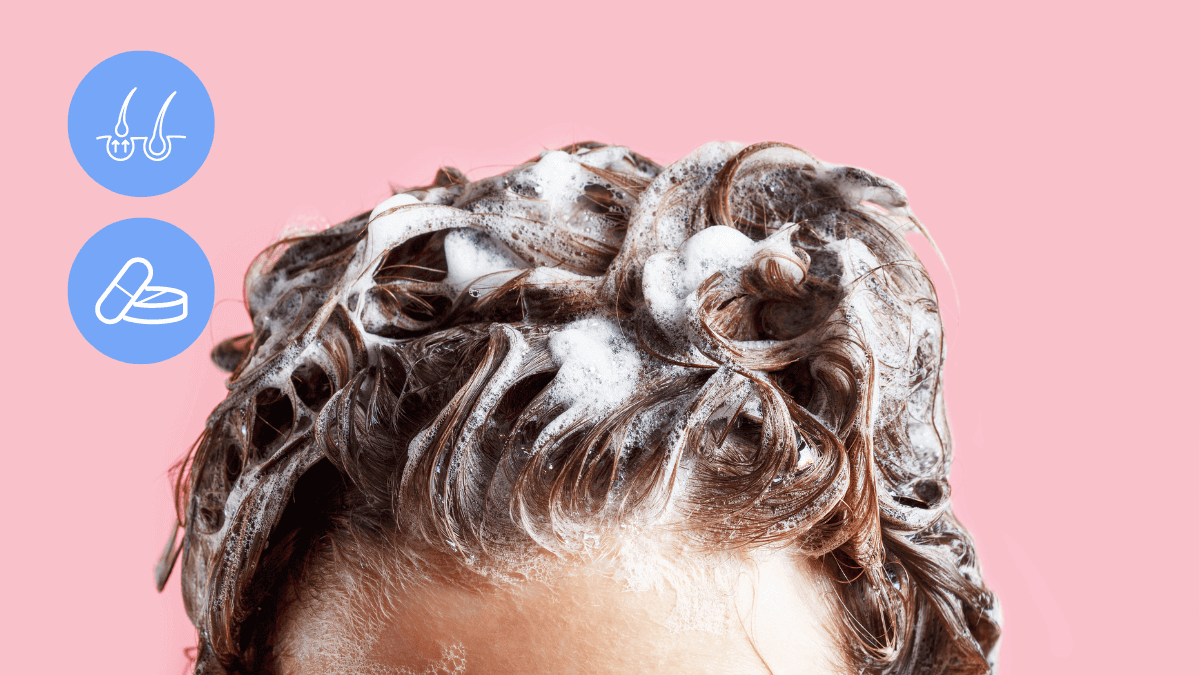TL;DR
▶ Minoxidil is a vasodilator. It boosts hair growth by increasing the blood flow to the scalp, resulting in thicker hair and healthier follicles.
▶ After a hair transplant, experiencing hair shedding or hair thinning is very common. Minoxidil is a great supplement medication for preventing that in transplanted areas and others.
▶ After waiting until a month following the surgery, you can safely start using Minoxidil as either an oral pill or as a foam (or liquid) to put it directly on your scalp.
▶ The risks that Minoxidil aims to minimize or even wholly eliminate are long-term effects. Similarly, to benefit from Minoxidil, you must continue using it periodically for a long time, at least for a year after the surgery.
A common misconception in our field is that many believe hair transplants are limited to surgeries.
Usually put forward by inexperienced or fake clinics, this notion causes a lot of patients to have unsatisfying hair transplant results.
However, in truth, to ensure a better chance of success, you have to take supplement medications following the surgery.
👉 You wouldn’t want to lose your transplanted hair just a year after surgery, especially when avoiding transplant failure is quite achievable with supportive medications such as Minoxidil.
In this blog, I will give you the benefits of using Minoxidil after a hair transplant, explain why it is crucial for your hair’s survivability, and possibly clear your doubts about using it:
Table of Contents
Let’s start by understanding what it is:
What Is Minoxidil?
Minoxidil is one of the most popular FDA-approved medications for treating male pattern baldness (MPB).
You can benefit from it either in the form of an oral medication that you can get with a prescription or as a topical foam (or a liquid solution) that you can buy from any pharmacy or by simply ordering it online.
🔷 Minoxidil is prominent for being an effective supplement medication against androgenetic alopecia (AGA) that you can use alongside more direct options such as a hair transplant. However, it is NOT a “cure” for completely eliminating the potential for further hair loss, especially not overnight.
Still, with what it does, it has a high reputation, which is why it appears in the pharmacies under different brand names:
Minoxidil Brand Names
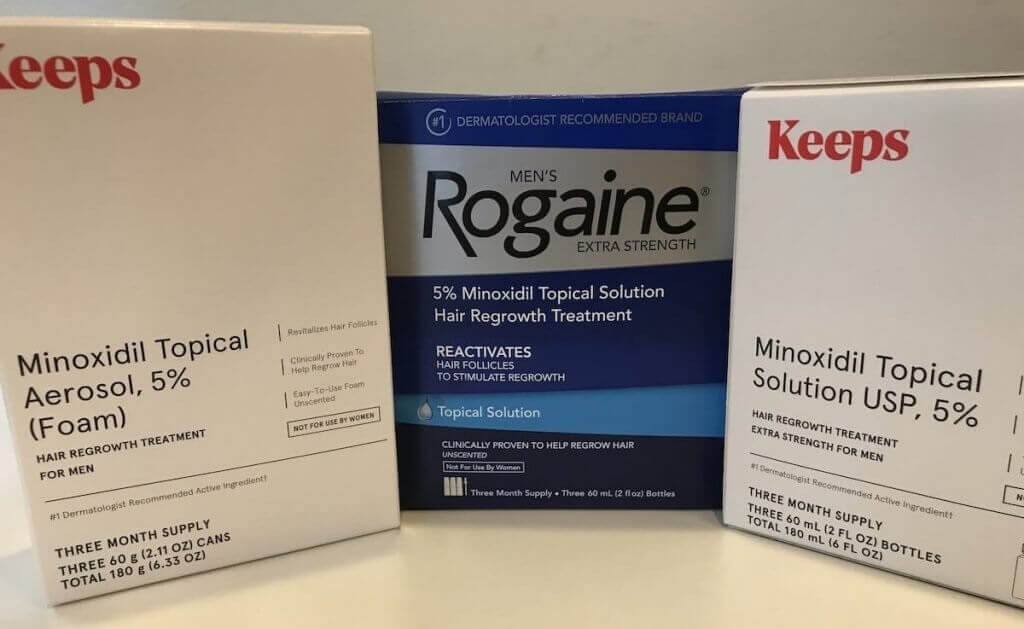
Although the medication’s name is Minoxidil, you will often see the name Rogaine used alongside it.
💡 That is because Rogaine is the most common brand name for Minoxidil. They refer to the same drug, but Minoxidil is the active ingredient inside Rogaine that is responsible for hair regrowth and is not exclusive to Rogaine.
In addition to Rogaine (and its UK counterpart, Regaine), the brands Loniten and Keep are other prominent ones with the same compound. Aside from having alternate uses (such as being a treatment for benign prostatic hyperplasia), these medications can also differ depending on the amount of Minoxidil, which is usually between 2 and 5%.
After consulting with your doctor and considering your medical history, you can find the optimal dosage for you.
However, regardless of the dosage, its working principle is the same in every brand:
How Does Minoxidil Work?
First, we should clear out the misconceptions about Minoxidil.
Minoxidil does NOT directly cause you to magically regrow lost hair, especially if your balding area has wholly lost its hair follicles. Instead, it works by supporting your body’s natural hair growth and replenishing process.
To properly explain, Minoxidil works and helps you regrow lost hair by doing two things:
1️⃣ Minoxidil is a vasodilator that boosts hair growth by increasing the blood flow to your scalp.
Vasodilators are medications that widen the blood vessels. For the same reason, Minoxidil’s initial use was for treating high blood pressure when it was discovered that it improves blood flow by dilating blood vessels.
Today, as a medication for MPB, its vasodilatory qualities are one of the primary ways it helps support hair growth. When you apply it to your scalp, your blood vessels around the balding areas are widened, which in turn causes more blood containing oxygen and healthy nutrients to flow into your scalp. This process feeds your follicles more, promoting a quicker growth of new, thicker, and healthier hair, which fights the excessive balding you are experiencing by slowing and stopping it.
2️⃣ Minoxidil replaces thinner hair.
Contrary to popular belief, hair shedding is NOT the only way to experience visible balding on your scalp. In fact, due to MPB, most of your hair follicles experience shrinking before shedding. This process can come to such a degree before falling out that your hair can look thinner and bald even before you start losing it.
Minoxidil contains a particular type of nitric oxide moiety, which is part of a molecule that can bind to nitric oxide and cause your hair follicles to shed and stimulate the growth of new follicles to start replacing shed hair with thicker hair more quickly.
Overall, its process is simply about boosting your body’s natural hair growth in the right direction, the right direction toward your new shining hair.
So, considering its chemical process, how should you decide whether you can start using it, especially after a hair transplant? By checking if you meet the measures:
Should You Use Minoxidil After a Hair Transplant?
Minoxidil is a very beneficial medication against MPB.
However, simply because you have experienced any level of hair loss does not mean that Minoxidil will be the right choice for you. As we have stated, there are examples, such as when a patient completely loses hair follicles in a bald area, where Minoxidil will simply not work.
In this case, we have some key points to help you decide if it is too late to use Minoxidil or not. According to studies, Minoxidil is much more effective in patients with the following:
➡️ Male Pattern Baldness/Androgenetic Alopecia
➡️ Smaller areas with hair loss, especially in other parts aside from your transplant
➡️ Progressing hair loss for under five years
➡️ Central hair loss rather than frontal hair loss
So, if you have decided on getting a hair transplant because an area in your scalp has experienced complete hair loss that led to balding, Minoxidil can NOT help.
Alternatively, if you have NOT used Minoxidil after getting a hair transplant for a very long time and you have had excessive hair shedding for quite some time, then it might be too late for Minoxidil in this case as well.
But, if you have been experiencing hair loss relatively new, or recently you have started experiencing it in a completely new area after a hair transplant, then Minoxidil is the right choice for ensuring that great hair sticks around.
Now, let’s talk about how exactly it can guarantee that future:
How can it help?
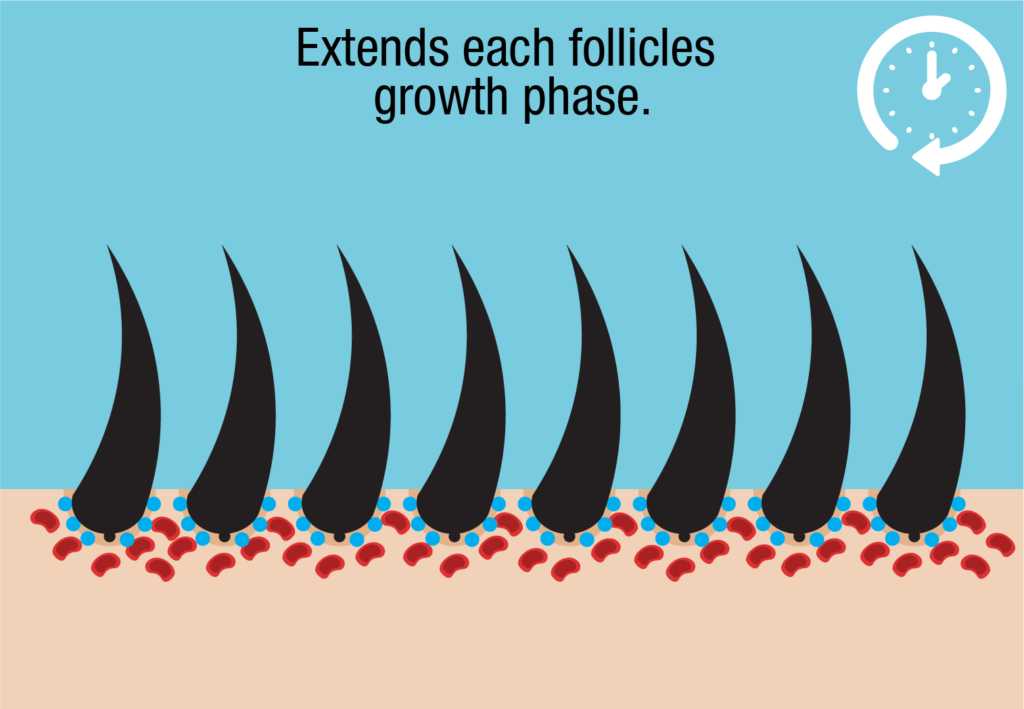
Source: The official website of Regaine.
According to various studies, Minoxidil can help a patient after a hair transplant in three ways:
1️⃣ Minoxidil can help by supporting the growth of your newly transplanted hair.
The success or failure of a hair transplant is defined by the number of hair follicles that survive the first year of the post-surgery process.
Naturally, there is a chance that your body can reject some of the transplanted hair. In this aspect, Minoxidil does a great job of minimizing the loss or covering it entirely, as using it periodically after a hair transplant can significantly accelerate new hair growth.
I advise you to use topical Minoxidil starting after the first month and continue until the end of the 12th month.
2️⃣ Minoxidil can help by eliminating post-surgery shock loss.
A hair transplant is an experience that creates a lot of immense physical trauma on your scalp. So naturally, after the surgery, some of your non-transplanted hair can fall victim to shedding, which we call shock loss and is completely normal. 🌱
Minoxidil, in this case, is recommended after a hair transplant because it reduces the risk of shock loss. Hair loss due to shock loss is typically temporary, but sometimes, it can lead to further hair shedding that does not grow back. Minoxidil eliminates this phase and possibility.
3️⃣ Minoxidil can help by removing the potential for further hair loss.
The parts of your scalp that did not get a hair transplant are still vulnerable to the effects of MPB. Depending on your age, it is still highly likely that further hair loss will appear on other parts. To prevent this scenario and the need to undergo another hair transplant surgery in the future, you should get the help of Minoxidil.
⚠️ Remember: There are many different options for Minoxidil. That is why you should consult with your doctor about which one is right for you.
After finding which form of Minoxidil is suitable for you, then we can jump into how to apply them:
How Should You Use Minoxidil After a Transplant?
Minoxidil’s topical solutions and foams are mostly preferred for treating hair loss.
The general directions of these medications suggest using 1 ml of the liquid solution or half a cap of the foam on the scalp twice a day, focusing on the areas with hair loss. You also can, of course, use 1 mg of oral pills daily, too, if you prefer.
However, to safely benefit from Minoxidil as much as possible, you should know when to stop or resume Minoxidil:
When should you resume Minoxidil after a transplant?
In our clinic, we suggest our patients wait until a month after surgery has already passed to give their scalp some time to rejuvenate after the hair transplant.
Furthermore, to minimize any potential side effects from Minoxidil, we suggest using it by applying 1 ml of topical solution on the affected area/s twice a day.
The side effects are very rare but still possible, so you should look out for them. Those side effects include:
- Scalp sensitivity.
- skin dryness,
- irritation around the application site,
- and increased heart rate.
There is also one additional thing that may seem like a side effect is that due to the way the medication works:
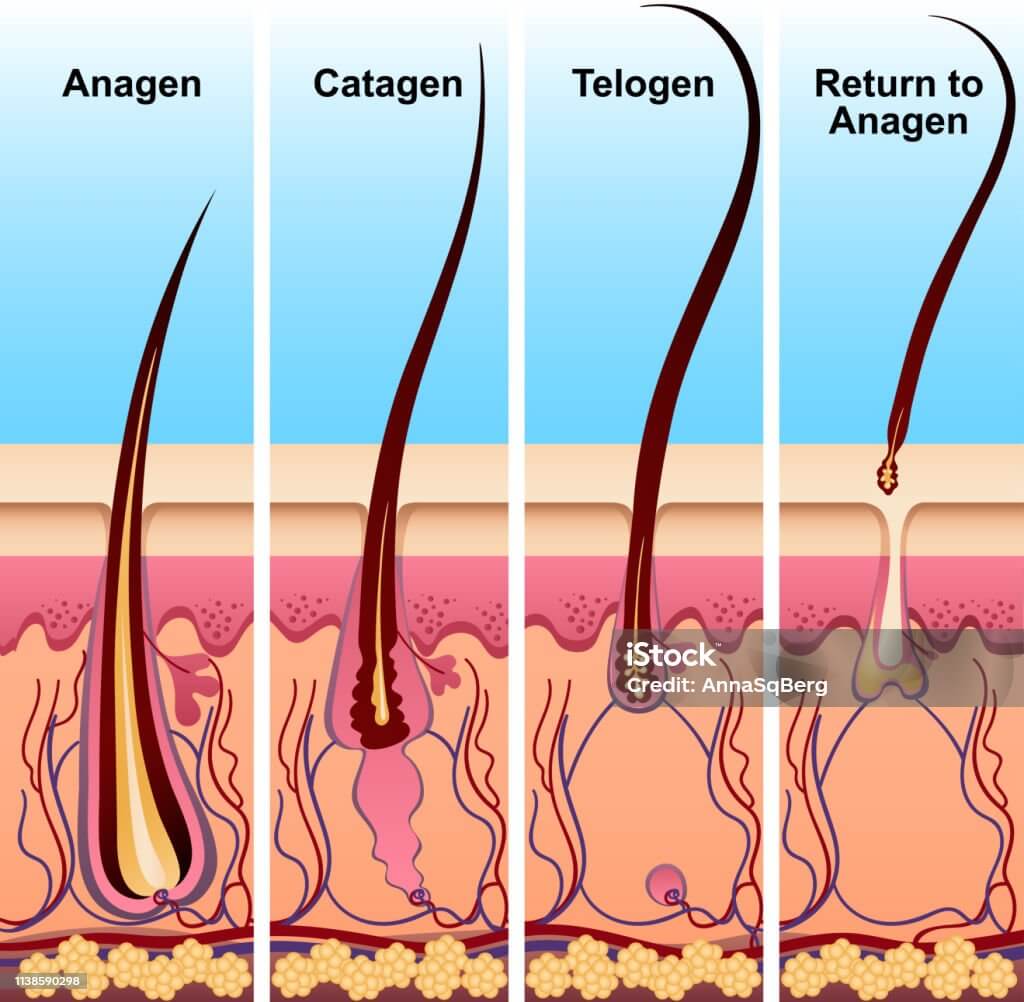
👉 Minoxidil causes some amount of hair loss due to temporary shedding only in the initial phase; however, this is NOT permanent.
Drugs with Minoxidil active ingredients cause all the hair in the telogen phase to fall out because by increasing the blood flow in the scalp, Minoxidil quickens the body’s hair recycling process.
That is why, after the first 4-8 weeks, your scalp enters the anagen phase and starts regrowing hair.
This is the reason for your hair loss, a temporary side effect due to the way Minoxidil works.
As it is NOT permanent, when a person starts using Minoxidil, they should continue using it for at least 4 months.
No need to stress and panic; just keep using it. And you will achieve great results. 🍀
Remember, you can always stop using it the moment these mild side effects become severe. If that happens, notify your doctor immediately. 🩺
But mostly, as these side effects are pretty rare, you can safely use Minoxidil for a long time.
In most cases with no concerning side effects, we advise our patients to simply follow the suggested standard amount of time for using it after surgery:
How long should you use Minoxidil?
One thing I clear out to all my patients before suggesting this product is that it will NOT make your hair thicker overnight as it is NOT a one-time solution.
Unlike direct physical solutions like hair transplant surgeries, Minoxidil may take several months, up to 1 year or more, to show results, so you have to be patient.
*️⃣ However, if your body responds well to the medication, its benefits will continue to be effective as long as you keep using it. In a study, 62% of the 984 men using 5 percent Minoxidil continuously over a year reported a reduction in hair loss.
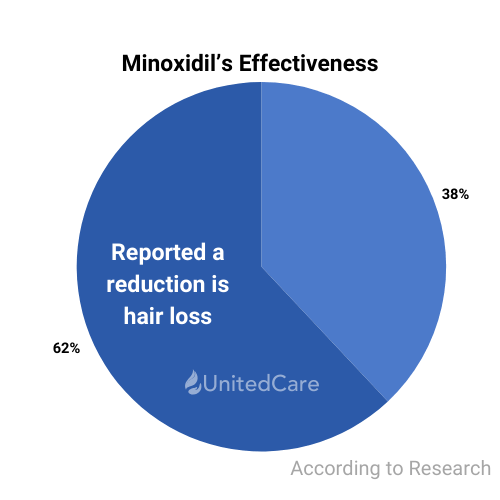
Overall, Minoxidil appears as an effective supportive method with various options to contribute to your body’s healing process in a very natural process. ☘️
As long as you are eligible to use it, Minoxidil can prove to you that it is not too late to save your hair’s future by slowly recreating the ideal image in your head into reality.
Now, to get an opinion from real people who have used Minoxidil, let’s take a look at online patient reviews:
What Do Minoxidil Patients Say?
In addition to several studies we have mentioned throughout this article, experiences from old hair loss patients who have used Minoxidil can help you get an insight about the medication.
Let’s start with the first one:
1 – Reddit user Mikex69 who used Minoxidil %5 only
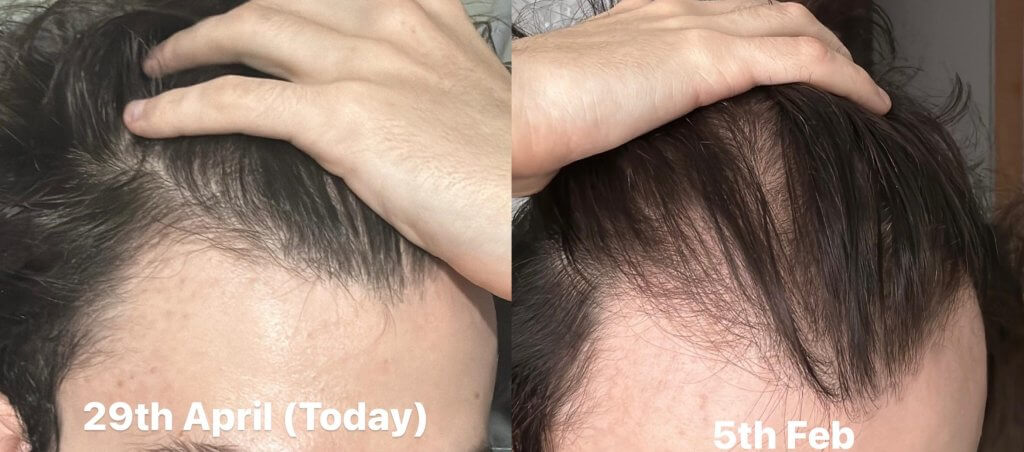
These pictures are from a 23-year-old Reddit user who has made visible progress only after 3 months on 5% topical Minoxidil Rogaine.
According to the answers he gave throughout his post, alongside his hair density, his confidence has also increased.
Considering that he, too, was an MPB patient, this can be a testament to how Minoxidil can be even more helpful in the early stages of balding.
2 – Reddit user noone168 who combined Minoxidil with head massages, biotin, and a healthy life
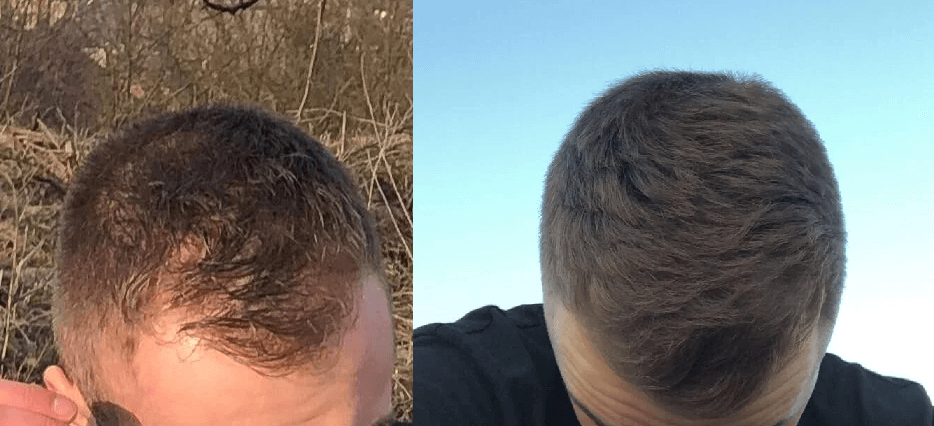
The visible progress shown in the picture is from a Reddit user who used 1 ml liquid Minoxidil for 6 months.
According to the more in-depth explanations he gives in the thread, he also combined Minoxidil with head massages and used collagen shampoo that contains biotin.
He also started to take care of his body and hair by eating healthier with lots of vitamins and stopping his drinking habit.
In answer to some concerns regarding Minoxidil, he explained that the initial shedding stopped after the first month.
Lastly, he remarks that if anyone has experienced or is afraid of experiencing the side effects of Finasteride, Minoxidil can be a great alternative, as was the case for him.
3 – Reddit user Illustrious-Way986 believes Minoxidil eliminated the need for transplant
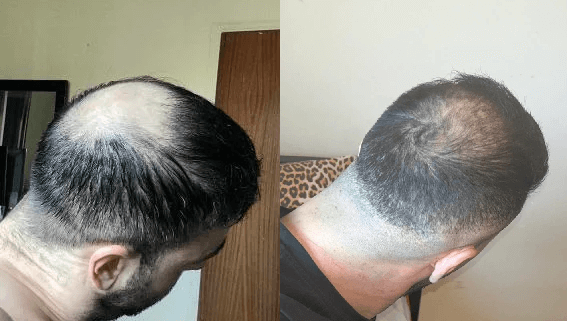
This is the story of a Reddit user who had a hair transplant on his frontal area only but also experienced hair loss on the crown and midsection.
After having his first transplant, he starts using Minoxidil before it is time for the second surgery. Within 3 months, he began to see visible improvement.
In the first couple of months, the scalp has gone through a shedding phase, so the bald area seemed to get bigger temporarily. However, towards the end of the last month, the whole crown area was filled with new hair.
This is an excellent example of how Minoxidil can be a great support for hair transplant to eliminate the chance for further hair loss and support regrowth, especially on the back zones of the scalp, such as the crown.
Now, remember, this is just Minoxidil alone, and within 3 months of using it. Just imagine what wonders it can do when combined with the proper treatment and the right clinic.
However, if you are still unsure about using it and have questions, do not worry. You can always reach out:
UnitedCare – a holistic approach for a balding-free life 🩺
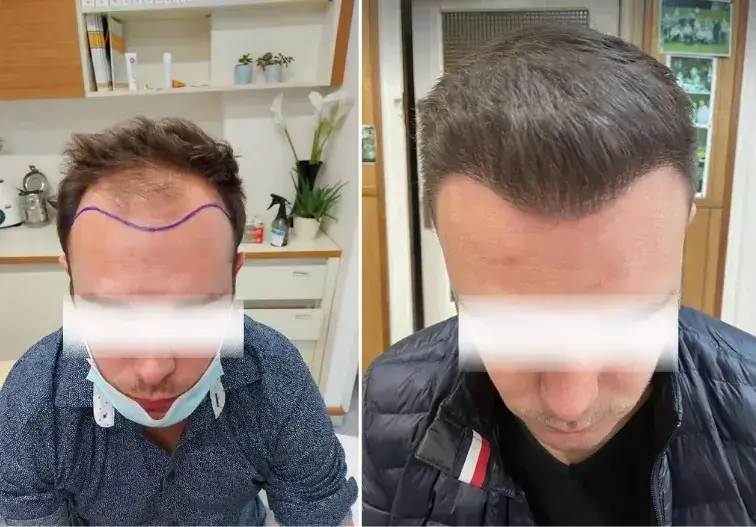
At UnitedCare, we begin your hair restoration process by offering you a free one-on-one consultation with our expert doctors to determine your suitability for using Minoxidil and getting a transplant.
💊 If suitable, our holistic approach provides advanced technologies and bio-enhancements to ensure you do not need more than a single hair transplant.
Once we have decided on a method together, we begin the treatment with the utmost attention. 💉
But most importantly, we stay in contact with our patients even long after the surgery, ensuring that your transplant becomes permanent and that Minoxidil shows its effectiveness. 🍀
Affordable hair transplant costs, a holistic approach, and experienced dermatologists on-site are here to provide you with the right solution.
Ready to learn more along the way? Click here to begin the first step:
Maximize the success rate of your hair transplantation with Minoxidil.
Restore your natural look with UnitedCare‘s expert dermatologists:
Frequently Asked Questions (FAQs)
Does Minoxidil Thicken Transplanted Hair?
In a way, yes, it helps. Minoxidil is a vasodilator that works by widening the blood vessels. As a result, more oxygen, enzymes, and healthy nutrients are transferred to your scalp. That process causes your body to grow your hair thicker, brighter, and healthier. Your transplanted hair will still need oxygen and nutrients to grow. In fact, they will need more now due to the physical trauma of the surgery affecting. Minoxidil helps your existing hair, and your transplanted hair thickens and healthily grows. Without a supplement medication such as Minoxidil to battle the effects of shock loss, your body can potentially reject the transplant.
Can You Use Minoxidil in the Donor Area?
Yes, you can. Minoxidil does not directly affect your hair’s growth. Instead, it helps your body’s natural growth by widening your vessels to carry more oxygen and nutrients. By supporting your hair follicles, your existing hair can grow thicker. Therefore, as Minoxidil does not come in direct contact with your hair in the donor area, it is safe to use. Still, in our clinic, we advise our patients to wait until a month after the surgery has already passed to give their bodies some time to recover. After that, we advise that you use Minoxidil on all the areas of your scalp for up to a year after the surgery to increase its success and avoid further hair shedding.
Why Are Transplanted Hairs So Thin?
A hair transplant is a very stressful process. During, before, and after the surgery has already finished, patients experience heavy physical and mental stress. As a result, your body reacts by often causing your transplanted and existing hair to get thinner by shedding. We call this shock loss. It is a natural process that heals itself over time. However, sometimes, it is possible to experience shock loss at a level that may cause severe hair loss in other parts of your scalp or cause your transplant to fail, which means losing most of your transplanted hair. Therefore, we highly suggest using supplement medications, such as Minoxidil or Finasteride, before and after the surgery to prevent this phase.
What Are the Negative Effects of Minoxidil?
Like every other medication, Minoxidil has some side effects. These mild side effects include scalp sensitivity, skin dryness, irritation around the application site, and increased heart rate. Also, the side effects are temporary as they either heal over time or stop existing when you stop using the medication.
Is Minoxidil an Alternative to Hair Transplants?
Not strictly, but it mostly depends on at which stage your hair loss is. If you have started experiencing hair loss only recently with a small balding area, then Minoxidil can be an alternative hair restoration treatment with a doctor’s consultation. However, for more advanced cases with larger bald regions, a hair transplant may be necessary.
Do I Need to Use Minoxidil After a Hair Transplant?
You don’t have to, but you should. The success of your hair transplant surgery relies a lot on your post-surgery care, especially considering that your body will experience shock loss. In that case, a supplement medication such as Minoxidil is vital.
